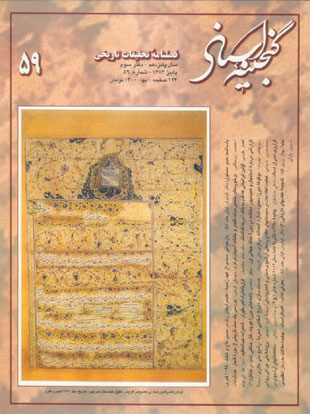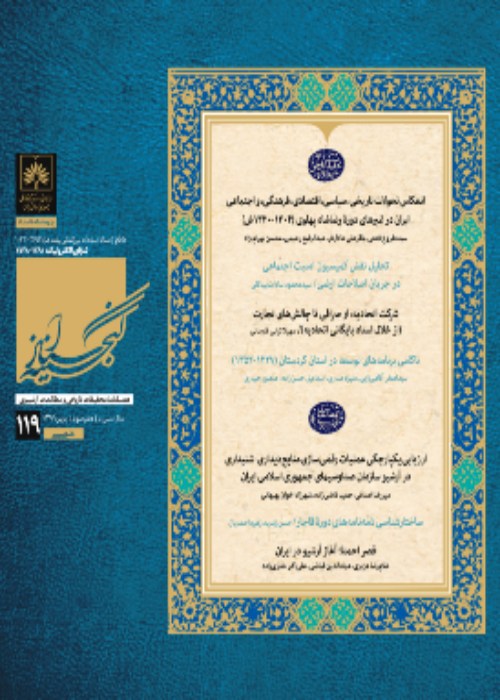فهرست مطالب

فصلنامه گنجینه اسناد
پیاپی 59 (پاییز 1384)
- تاریخ انتشار: 1384/08/24
- تعداد عناوین: 18
-
صفحه 26نقوش نمادین سنتی، محصول قرن ها تلاش هنرمندان، اندیشمندان وصنعتگران هر جامعه است که معانی عمیق و گسترده ای، به اختصار و موجز در آنها به تصویر درآمده است. گستره نماد، به گستردگی فرهنگ و هنر ملت هاست. و بحث نماد ها در ارتباط تصویری بسیار مهم و ارزشمند میباشد. نماد را در بحث های مختلف هنر گرافیک میتوان پیگیر شد. یکی از این موارد، استفاده از نماد در کارت می باشد. کارت یکی از محمل های کاربردی هنر گرافیک است که انواع آن شامل کارت های عضویت، اعتباری، کارت پستالها، کارت های تبریک، کارت دعوت و مانند اینها میباشد. این کارت ها اگر چه به منظور اطلاع رسانی به کار میروند، اما طراحی آنها از مباحث مهم گرافیک است و حامل بسیاری از نشانه و سمبل ها میتوانند باشند. در مقاله حاضر، با معرفی یک کارت دعوت از دوره قاجار، به بررسی مهمترین نماد های آن دوره پرداخته شده است.کلیدواژگان: قاجار، هنر گرافیک، هنر سنتی، هنر ایرانی، شیر و خورشید، اسناد ملی، نمادهای ایرانی
-
صفحه 89اسناد و سوابق، به عنوان ابزارهای کلیدی برای تدوام موثر و کارآمد فعالیت دستگاه های دولتی است و از اساسی ترین و مهم ترین راه های دسترسی به «هزار توهای تاریک و پنهان» وقایع و رویداد های گذشته به شمار میرود. بر این اساس، به منظور دستیابی به اهداف مزبور و نیز ساماندهی بهینه اسناد و مدراک، آرشیو و ملی هر کشور ملزم به ایجاد پرورنده ملی می باشد. با طراحی پرونده ملی، میتوان سوابق اطلاعاتی سازمان ها و موسسات دولتی را به شکلی صحیح و اصولی محافظت و نگه داری نمود و شرایط دسترسی به آنها را، در کمترین زمان ممکن برای همگان فراهم ساخت. در این مقاله ابتدا، مفهوم پروند از منظرهای مختلف بیان می شود و سپس اهمیت و منفعت های پرونده ملی و ویژگی ها و مشخصات آن و نیز نحوه نگه داری سوابق الکترونیکی و موقعیت پرونده ملی و ویژگی ها و مشخصات آن و نیز نحوه نگه داری سوابق الکترونیکی و موقعیت پرونده ملی در کشور مالزی، مورد بررسی قرار میگیرد.
کلیدواژگان: پروندهء ملی، تعریف پرونده، پوشه، سوابق الکترونیک، اسناد و سوابق اسناد -
صفحه 102
-
صفحه 104
-
صفحه 111
-
صفحه 112
-
صفحه 123
-
Page 5This article is transcription of a record from Zandiyeh era. Its subject is about Mohammad- Hossein Khan Qaragozlou appointment as the commander of the regiment and Jockey of Kohkiloyeh and its dependants. This governmental position vested him by Ali Morad-Khan Zand in 1780 AD. Troops had practice conscription and military exercise, in addition to providing there secure and transquility. The record has historical importance, besides that is very important from record recognition, its transcription, and acquintace with Zandiyeh literature and writing point of view. However, transcription of this governmental decree is an effective step to recognize the complicated writings of Zandiyeh era.
-
Page 11Iran territory had divided in Northwestern, Northeastern, and East, because of the ruling king's inefficiency. As a result, many parts of this territory were separated from it. A direct and long struggle between Iranians and Russians ended with the Treaty of Gulestan and Turkamanchay. Russians prepared the way for accepting the Akhal Treaty by supporting Middle East tribes and Khan's attacks to Iran, especially Khorasan. The author describes Central Asia Khans and tribe's historical geography in brief, and reviews the battles between Iranian army and Khiveh Khanates and Turkmans, on the basis of existing resources. He explains Marve battle, the reasons of Qajar armie's defeat, and the results of this failure. He also describes the faiths of ten-thousands of Iranian prisoners of war, military and civilian, in Middle East and Iran Northeastern insecurity.
-
Page 26Traditional symbolic impressions are the result of many centurie's efforts of artists, thinkers, and artisans of each society that portrayed profound meanings. The range of symbol is similar to the expansion of people's cultures and arts. Symbols are very important in pictorial communication. We can find symbols in different fields of graphic art. One of these is the use of symbols in cards. Card is one of applied manner in graphic that its different kinds are: membership, credit, postal, congratulation, invitation. Their designs are important parts in graphic, that included many symbols and marks, although cards are used for information. In this article, some important symbols of Qajar era examines by introducing an invitation card of that era.
-
Page 32Abbas Mirza sent two Iranian students to England in 1811, to study Medicine and Painting. From this time, the process of student's dispatch to Europe was continued. After one century, an Iranian student named Seyyed Hossein Motarjem Nezam Madani went to America. He was the first Iranian student that dispatched there. Of course, Mirza Mohammad Saiyah is recognized as the first one who went there, but not for education. This article reviews the brief history of student's dispatch to Europe. The author describes the communication establishment method between Iran and America by introducing and explaining some aspects of six Iranian travels to America in Qajar's era.
-
Page 41Naser-AI-Din Shah visited many modern institutions and European civilization works during his three travels to Europe. Then he decided to establish railway in Iran. The concession of establishment and its put in working, granted to a Belgium engineer named "Fabious Bovatal". Sheikh Mohsen Khan, entitled Moshir-AI-Doleh, was elected to end the agreement and get the concession. Bovatal formed a company to construct the aforesaid railway, and sold its stocks to a Russian contractor, Lazar Poliakof. This company established "Iran Railway and Tramway Company". Finally, its construction finished in 1888 and the first 5-6 kilometers railway was established in Iran.
-
Page 58After The establishment of Shahanshahi (Royal) and Esteqrazi Bank (financial bank) in Iran, Naser-AI-Din Shah tried to request loans from these two Banks. The most important loan that he took from Shahanshahi Bank was 500/000 Pound Sterling. In the beginning of Mozafar-AI-Din Shah's monarchy, these Banks gave some loans to the government that its processes continued until the Constitution and the beginning of the First World War, and the payment of these loans was guaranteed by customs revenues of southern, western and northern frontiers. These revenues were reduced by the expansion of the First World War to Iran, so Iran couldnt pay its dues and these countries give a delay to Iran. The author describes some of these issues and their influences on Iran political and economic situation.
-
Page 64This article is the continuation of its first part that published in this magazine, Vol. 2, Summer 2005, No. 58.
-
Page 75The article discusses the importance of endowment and introduces Mirza Mahmoud Sarem- OI-Mamalek Dargazi's endowment. Mirza Mahmoud is one of the dignitaries of Khorasan. He was born in Dargaz and graduated from its school. Mirza helped his family in farming and became elite horse rider after the Constitution. Dargaz ruling government appointed him as a commander. Then he was working as Lotf Abad deputy governor. He was presented in Khorasan events such as: Zebardast Khan's rebel, Khado Sardar, Turkmen's disarmament, Lahak Khan-e- Bavandi's rise,...Mirza Mahmoud given the title "Sarem-OI-Mamalek" in 1922 and was the governor of Dargaz, Radakan, Chenaran, Rokh section of Torbat Hidarieh. He bestowed many things like: creation of street, school, market, and mosque in Nokhandan; creation of school and bath in Borj Qale village; the construction of some houses and 10 shops in Khosravi Street of Mashhad for reading the Holy Koran, and preparing clothes and fuel for the poor and needy. He explained a short biography and the components of an endowment letter as: its content, Waqef (benevolence), endowment, its uses, custodianship, and its date.
-
Page 81The methodology of oral history is the same in all institutions which accepted its techniques and employed them. There is not any exact and definite method, but it can be divided into three stages: 1)Oral history gathering 2)Oral history preparedness 3)Oral history dissemination These stages are important, but there are other important aspects, such as oral history work's documentation, that must be considered. The purpose of this article, is describing the importance of documentation aspects in oral history projects and their analysis. This guidance can be useful for one whom created oral history and managed their recording.
-
Page 87The quality of data in traditional and electronic archival information systems is one of the public faiths in archival material, the significance of an archival institution in society and the use of archival material in research. Both archival information systems develop and, in practice, use different solutions to ensure the quality of data. The archivist must work on the standardization of procedures at national and international levels on assuring such quality.
-
Page 89Records are essential and key tools in effective continuation of governmental institution's activities and the most important and basic access way to hidden and unknown events of the past. So, National Archives of each country must create "National Dossier" for achieving these goals and organizing these records. The governmental organizations and institutions can preserve their informational records and files properly and prepared them for public access by this project. The author describes the meaning of dossier from different aspects, its importance and benefits; its characteristics and the preservation of electronic records and the situation of national dossier in Malaysia.
-
Page 96Comma is an International Journal on Archives. It is published four times a year and distributed free of charge to all members of the International Council on Archives (ICA). The translater of these abstracts tries to make known her colleagues with new articles on their profession.
-
Page 102This article, describes five archival buildings in England, Australia, and Switzerland. These buildings are conformed with universal standards. It also examines the record's linear feet and their preservation methods.


